 Chili Flake and Powder = Gochu-garu
Chili Flake and Powder = Gochu-garu
 Mild Flake = Deol-maewoon gochu-garu
Mild Flake = Deol-maewoon gochu-garu
 Hot Flake = Mae-woon gochu-garu
Hot Flake = Mae-woon gochu-garu
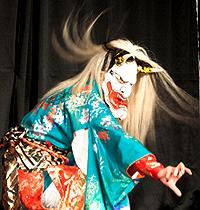
Chilis came were adopted rather late in Korea, and are
still a minor item in Japan. Chilis are thought to have been
brought to Korea by Portuguese mercinaries sent by the Ming Chinese
to help fighting the Japanese in Korea during the Imjin War (ended
1598). The Koreans had a taste for hot spices and began using them,
but it was 200 years later that they started using them in Kimchee,
and found they acted as a preservative, allowing less expensive salt
to be used.
More on Chili Peppers.
 [Fushimiama (mild), Fushimikara (medium hot); C.annuum]
[Fushimiama (mild), Fushimikara (medium hot); C.annuum]
These long narrow pointed chilis are a traditional variety in
Japan. They have a smooth, glossy skin, and grow to about 6 inches long.
They are highly variable in heat, depending on variety. Then can be
very mild, H0 to medium hot
H6. They can be used raw or
cooked, in salads, stir fries, ohitashi, tempura and yakitori. They
are also sautéed and eaten with sea salt same as
Shishitos. Photo borrowed from
Refining Fire Chilis
until the seeds I bought from them bear fruit.
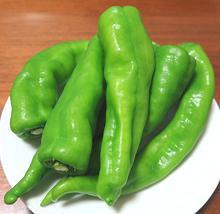 [C.annuum]
[C.annuum]
A traditional vegetable from Kyoto, Japan, it has thicker walls than
other Japanese chilis, and very little heat.
Used for tempura, yakitori, pickling, and sautéed with sea salt.
Photo © Motokoka distributed under license Creative Commons
Attribution-ShareAlike v4.0 International.
 [C. annuum]
[C. annuum]
Fresh green, 3 to 5 inches by 3/4 of an inch in diameter and tapered to a
slightly blunt point, hotness
H2-H4. These are found in Koran markets and in and some
multi-ethnic produce markets. They vary rather widely in hotness. Most
have very moderate heat, but I recently bought some red ones that were
about as hot as Holland Reds.
Subst: Indian Green Chilis, but
not the really hot ones.
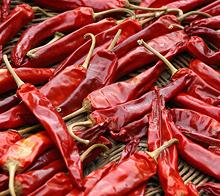 [Hong-gochu (red ripe), Put-gochu (mature green), Yeori-gochu (very young
green); C.annuum]
[Hong-gochu (red ripe), Put-gochu (mature green), Yeori-gochu (very young
green); C.annuum]
Though often eaten fresh green or red, this is the chili dried and
used for chili flake and powder (gochutgaru), and in Kimchee, and for
the ubiquitous Gochujang (Chili
Paste).
Photo © ASADAL, Inc. distributed under license Creative Commons
Attribution 2.0 Korea.
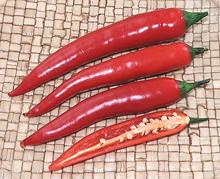 [oi-gochu, asagi-gochu (Korea); C.annuum]
[oi-gochu, asagi-gochu (Korea); C.annuum]
This is a very mild Chili now popular in Korea, green but also red. There is no official designation, so growers use these names for any variety that meets the flavor and hotness profile. They are generally eaten fresh green as crudités with dip, or in salads, but those I've found here in Los Angeles are red. Taste is similar to Red Anaheim.
The largest in the specimen batch was 4.9 inches long, not including the
stem, and 0.83 inches diameter at the big end (124 x 21 mm), weighing about
41 to the pound (0.4 oz / 9.6 gm each). They have definite sharpness up at
the stem end, so heat is about H2
for the stem end quarter. The photo specimens were purchased from a Korean
Market in Los Angeles (La Cañada). They are still quite rare (12-2020), so
sold at a high price, 2020 US $12.99 / pound.
 [C.annuum]
[C.annuum]
These long "string chilis" are quite mild if picked young at about 4
inches. More mature they get tough skins and higher heat. They can
be used raw or cooked, in salads, ohitashi, tempura and yakitori. They
are also sautéed and eaten with sea salt same as
Shishitos Photo borrowed from
Refining Fire Chilis
until the seeds I bought from them bear fruit.
 [Hontaka, Santaka, Yatsufusa (Japan); Chinese Chili; Tien Tsin (China);
| similar but may be a little hotter, Takanotsume
(Hawk Beak); C. annuum]
[Hontaka, Santaka, Yatsufusa (Japan); Chinese Chili; Tien Tsin (China);
| similar but may be a little hotter, Takanotsume
(Hawk Beak); C. annuum]
This chili originated in Jalisco, Mexico, but has become well known in
South and Southeast Asia, and are grown very extensively in China,
the second largest Chili exporter in the world (but less than half
India's exports). They are easily identifiable by having no caps or
stems. In North America, this is pretty much the default dried red
chili, available everywhere. It has good flavor and is moderately hot
at low to mid H7. They are
up to 2-3/4 inches long and 0.63 inch wide (70 x 16 mm) and fairly
plump.
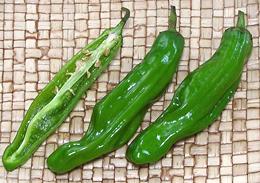 [Ggwari-gochu (Korea); Japanese Chile; C. annuum]
[Ggwari-gochu (Korea); Japanese Chile; C. annuum]
Used raw or cooked by several methods in both Korea and Japan.
These are now grown in California and widely available here, both for
themselves, and as a substitute for Spanish Padrónes and
Philippine Sili Mahaba. Fresh dark green (red ones are very rare),
these chilis have unique lengthwise ridges and blunt ends. They
have good flavor are generally very mild at
H0, but about 1 in 20 can surprise, cranking it up into the
high H1 range. They are usually
3-1/4 inches long and 1/2 inch diameter, but can be a bit larger. In
Japan and Korea, they are most often sautéed in hot oil and
eaten with sea salt.
Details and Cooking.
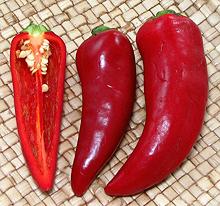 ["Red Jalapeno" (U.S. supermarkets); C. annuum]
["Red Jalapeno" (U.S. supermarkets); C. annuum]
This is not a Korean / Japanese chili (at least not yet), but it has
been chosen by all ethnicities in Southern California as the medium hot fresh
red chili suitable for their cuisines. Their hotness is about
H4-5. Core and seed them, but
leave in the membranes (where the heat is) if you want heat. With the
membranes carefully removed they have little heat. They have good
flavor, and the walls are quite thick, so they are not dried. For details
see our Fresno Chili page.
 [C. annuum]
[C. annuum]
These are not a Korean / Japanese chili (yet), but they are now quite popular in Thailand, In North America, they are the go-to for fresh hot green chilis when chilis native to a particular cuisine are not available. These have more flavor than most hot green chilis - but nobody seems to be complaining.
Serranos are fairly hot (about
H6), but the heat can be greatly reduced if necessary, by
removing the seed mass and membranes. They can be up to 4.5 inches
(11.5 cm) long and 0.8 inch (2 cm) diameter. The flesh is fairly thick,
so they are not dried.
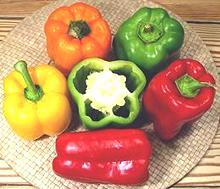 [Piman (Japan); Tian Jiao (China); Shimla Mirch (India); Capsicum
(British); Bell Peppers (North America); C. annuum]
[Piman (Japan); Tian Jiao (China); Shimla Mirch (India); Capsicum
(British); Bell Peppers (North America); C. annuum]
These are used throughout Asia, with China the largest grower and
exporter in the world, and they have become quite important in almost
all cuisines. Box shaped to heart shaped, these are up to 5 inches
(12.7 cm) across here in California, but may be a bit smaller in some
countries. They feature thick, crisp and flavorful flesh with no
heat (H0). The Japanese Piman
is a bit smaller and has thinner walls than the North American variety.
The walls are very thick with a high water content, so they are not
dried except industrially for food processors.
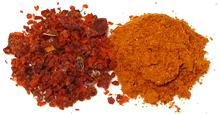
[Gochu-garu (flake); Gochujang-yong-gochu-garu (powder)]
Hotness of the flake varies, but is usually between
H2 and H3, sweet and tasty to
moderately hot. Whether it's hot or mild will be written in Korean - see
below, noticing that the first character is different for Mild. If there is
any English it will probably just say "Chili Powder" for powder and flake.
The powder tends to be quite a bit more variable than flake, and can be as
low as H3 and as high as H5.
In general, for powder, the brighter the red color the milder it will be,
but that's not totally reliable. Both flake and powder are used liberally
in kimchi and other Korean dishes, so turnover at Korean markets is quick
and the product is generally of excellent quality.
 Chili Flake and Powder = Gochu-garu
Chili Flake and Powder = Gochu-garu
 Mild Flake = Deol-maewoon gochu-garu
Mild Flake = Deol-maewoon gochu-garu
 Hot Flake = Mae-woon gochu-garu
Hot Flake = Mae-woon gochu-garu
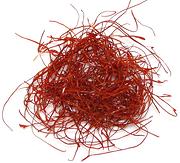
[Silgochu (Korea)]
These threads are used as a garnish for some Korean dishes. They are around H3, sweet and tasty. They used to be laboriously cut with scissors, but it's now done by machine.
The photo specimens, about 0.019 inch wide and up to 4-1/4 inches long,
were purchased from a Korean market in Los Angeles for 2015 US $14.19 for
6.5 ounces ($34.93 / pound). The weight used in a recipe is minuscule, so
6.5 ounces will last a very long time. Problem is, they lose their bright
red color in a year or so, which makes them useless as a garnish. For this
reason, I usually seed Fresno chilis and cut into strips as thin as I can,
then use them fresh, or dry them in my dehydrator for thinner.

[Ichimi (One Flavor) (Japan); C. annuum]
This is ground from Japone / Takanotsume type chilis so will be
quite hot. It is used to spice up Udon soups, and in Shichimi (seven
flavors) powder found in Soba shops. The specimen to the left is
Japone powder.